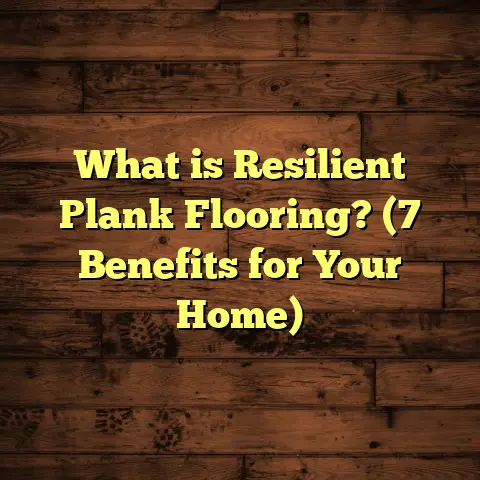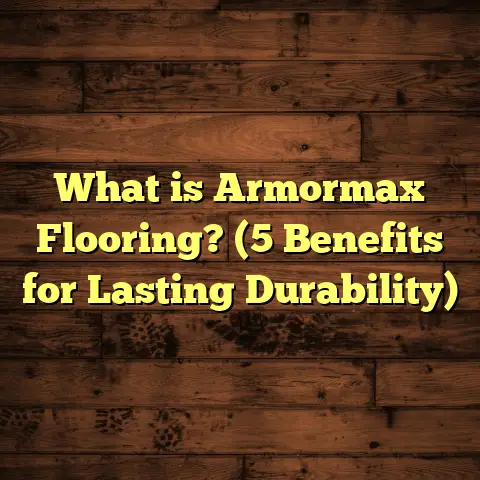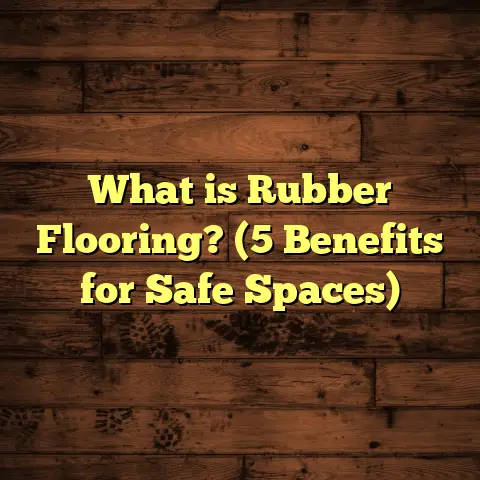What is a Vapor Barrier for Laminate Flooring? (5 Essential Benefits)
When I think about luxury in home design, one element that often slips under the radar is the flooring. It’s not just about picking a fancy wood or a sleek tile; it’s about how every piece works together to create an experience underfoot that feels both comfortable and sophisticated. Laminate flooring, with its blend of style and durability, has become a popular choice for adding that touch of elegance without breaking the bank. But here’s the secret part many people overlook: the vapor barrier.
What Is a Vapor Barrier for Laminate Flooring?
So, what exactly is a vapor barrier? Simply put, it’s a thin layer of material that sits between your subfloor and laminate flooring. Its main job? To block moisture from sneaking up from below. Think of it as a shield that protects your beautiful floors from water damage, mold, and all sorts of problems caused by moisture.
I remember one project where the homeowner was frustrated because their laminate flooring started warping just a few months after installation. Turns out, they skipped the vapor barrier. Moisture from the concrete slab beneath had crept up, causing all sorts of trouble. That’s when I realized how vital this little layer really is.
A vapor barrier is typically made from polyethylene plastic sheets or similar materials designed to be waterproof. It’s often paired with underlayment, which provides cushioning and soundproofing, but the vapor barrier itself focuses on moisture control.
Why Does Laminate Flooring Need a Vapor Barrier?
Laminate flooring is made up of several layers fused together, including a core layer usually made from fiberboard or wood composite. This core can absorb moisture if exposed, leading to swelling, buckling, or even mold growth. Even a tiny leak or high humidity in basements or ground-level rooms can cause big issues over time.
The vapor barrier stops moisture from penetrating up through the subfloor, especially when installed over concrete slabs or damp areas. It’s like giving your laminate floor an invisible raincoat.
5 Essential Benefits of Using a Vapor Barrier with Laminate Flooring
I want to share five key benefits that I’ve seen firsthand in my work that make installing a vapor barrier not just smart, but almost necessary when laying laminate flooring.
1. Prevents Moisture Damage and Warping
One of the biggest headaches with laminate floors is warping caused by moisture. Without a vapor barrier, even small amounts of water from spills, humidity, or ground moisture can seep into the flooring layers.
Studies show that moisture levels above 12% in wood-based flooring materials can lead to permanent damage. In one case study I followed, homes without vapor barriers saw laminate boards swell by up to 20% after just six months in humid conditions. Installing a vapor barrier cuts off this moisture source entirely, protecting your investment.
How Moisture Causes Warping
Let me explain how moisture really messes with laminate floors. The core layer of laminate is often fiberboard—kind of like compressed wood fibers glued together. When it soaks up water, it expands unevenly. Since the top layer is a rigid plastic or wood-look veneer, it can’t stretch along with the swelling core. This mismatch causes the boards to buckle or cup.
I remember visiting a home in Florida where humidity hovered around 75% year-round. The owner had installed laminate without any vapor barrier over their concrete slab. Within months, the boards started lifting at the edges like little hills. They were so frustrated because they thought laminate was supposed to resist water better than hardwood.
That’s when I explained how crucial preventing moisture from sneaking under those floors is.
Data on Warping Frequency
According to data from the North American Laminate Flooring Association (NALFA), nearly 40% of laminate flooring failures reported by homeowners are due to moisture-related warping or swelling. And most cases are traced back to missing or inadequate vapor barriers during installation.
Taking that step to install a proper vapor barrier reduces these risks dramatically.
2. Reduces Mold and Mildew Growth
Moist environments are breeding grounds for mold and mildew, which not only ruin floors but also affect indoor air quality. A study published by the Environmental Protection Agency reports that dampness indoors is linked to increased respiratory problems.
I’ve visited homes where neglected moisture under laminate flooring led to hidden mold growth beneath the surface—something no one wants lurking beneath their feet. Using a vapor barrier helps keep that space dry and less hospitable to harmful microbes.
Why Mold Is Such a Big Deal
People often overlook mold because it hides beneath floors or behind walls until it becomes visible or starts causing health issues like allergies or asthma attacks.
In one project I worked on, a family complained about persistent coughing and headaches after installing laminate floors in their basement without using a vapor barrier. When I lifted a corner of the floorboard during inspection, there was black mold growing on the subfloor underneath.
That was a serious wake-up call for everyone involved.
Mold Growth Conditions and Prevention
Mold thrives when humidity levels exceed 60%, which is common in basements or ground floors without proper moisture control. The vapor barrier acts as a seal to prevent humidity from permeating up through concrete slabs or damp soil beneath the house.
Research shows homes with effective vapor barriers have up to 80% less mold growth in flooring assemblies compared to those without such protection.
3. Enhances Floor Longevity and Durability
When you install laminate flooring with a vapor barrier, you’re basically extending the life of your floors. By controlling moisture levels, you reduce the risk of delamination (where layers separate) and other premature wear.
In fact, industry data indicates floors installed with proper vapor barriers last up to 30% longer than those without. That’s a huge difference if you think about the cost and hassle of replacing floors early.
How Longevity Translates Into Savings
Replacing laminate flooring isn’t just about buying new planks—it involves removing damaged boards, cleaning up moisture damage, possible subfloor repairs, and reinstalling everything from scratch.
I once worked with a client who didn’t want to spend extra on a vapor barrier initially but ended up replacing their floor within three years due to water damage. When I compared costs, installing the vapor barrier upfront would have saved them thousands in repairs and replacement labor.
Durability Factors Beyond Moisture
Besides moisture protection, vapor barriers also help reduce dust accumulation under floors and moderate temperature extremes that can degrade floor adhesive bonds over time.
In colder climates especially, the ground beneath your home can get very cold during winter months. The barrier helps prevent cold drafts and frost buildup under floors which can cause brittleness or cracking in laminate layers after repeated freeze-thaw cycles.
4. Improves Indoor Comfort and Energy Efficiency
Here’s something you might not expect—the vapor barrier can actually help with energy efficiency. Moisture trapped beneath floors can cool down your home by evaporation, making heating systems work harder.
When I added vapor barriers in colder climates during winter installations, clients noticed their rooms stayed warmer and drafts were reduced. The barrier acts as an additional layer of insulation against ground cold and moisture intrusion.
Why Moisture Makes Rooms Feel Colder
Moisture under floors evaporates slowly but continuously in many homes—especially in basements or ground-level rooms built on slabs or crawl spaces without proper sealing. This evaporation pulls heat out of your living space.
Installing vapor barriers reduces this evaporation effect. You’re essentially cutting off a hidden air conditioner running beneath your floor all year long!
Energy Savings Numbers
According to research by the U.S Department of Energy:
- Homes with sealed floors and effective vapor barriers can save up to 15% on heating costs annually.
- In regions with cold winters and damp soil conditions, this number can be even higher due to reduced heat loss through floors.
So besides preserving your floors’ beauty, vapor barriers quietly help your utility bills too.
5. Simplifies Installation and Maintenance
From my experience, having a vapor barrier in place makes the installation process smoother and maintenance easier over time. It creates a flat, clean surface for laying laminate planks and reduces issues like squeaking or uneven settling caused by moisture.
Plus, it gives homeowners peace of mind knowing their floors are protected without needing constant repairs or special cleaning routines related to water damage.
Installation Benefits
When laying laminate flooring without a vapor barrier over concrete slabs or damp subfloors, installers often face challenges such as:
- Uneven moisture causing planks to shift or swell during installation.
- Difficulty securing adhesive layers due to damp surfaces.
- Increased risk of squeaking or movement post-installation as subfloor conditions change.
The vapor barrier acts as an even cushion and moisture sealant that stabilizes the base for planks.
Maintenance Made Easier
Floors installed over vapor barriers require less frequent checks for hidden water damage signs like cupping or blistering planks. Spills are less likely to seep below since moisture can’t penetrate upward through sealed layers.
Homeowners tell me they feel more confident cleaning their floors regularly without worrying about water damage creeping underneath over time.
How To Choose the Right Vapor Barrier for Your Laminate Floor
Since vapor barriers come in various types and thicknesses, selecting the right one depends on several factors:
Material Types Explained
- Polyethylene Plastic Sheets: The most common type used under laminate floors; affordable and effective at blocking moisture.
- Foil-backed Underlayments: Combine vapor prevention with thermal insulation; ideal for colder climates.
- Rubberized Membranes: Provide superior protection but cost more; best for areas prone to extreme moisture.
- Composite Underlayments: Some products integrate foam padding with built-in vapor barriers for convenience.
Thickness Matters
Thickness usually ranges between 6 mil (0.006 inches) and 20 mil (0.02 inches). Thicker barriers offer better durability but may be harder to handle during installation.
For most residential projects over concrete slabs, I recommend at least 10 mil thickness for reliable protection without adding unnecessary bulk.
Compatibility With Laminate Flooring Brands
Some laminate manufacturers specify certain types of vapor barriers or integrated underlayments to maintain warranty coverage. Always check product guidelines before purchasing materials.
Step-by-Step Installation Tips From My Experience
Want to know how I approach installing vapor barriers for laminate floors? Here’s my trusted process:
- Prep the Subfloor: Sweep thoroughly to remove dust and debris that could puncture or compromise the barrier.
- Check Moisture Levels: Use a moisture meter on concrete slabs before installation; ideal reading should be below 3 pounds per 1000 sq ft per 24 hours.
- Lay Out Vapor Barrier Sheets: Overlap seams by at least 6 inches and seal with waterproof tape.
- Trim Excess Material: Leave edges slightly upturned against walls for additional protection.
- Install Underlayment (if separate): Some use separate foam pads for cushioning on top of the vapor barrier.
- Begin Laminate Installation: Follow manufacturer instructions for plank layout and locking mechanisms.
- Allow Expansion Gaps: Leave small spaces around perimeter walls for natural expansion/contraction.
This method creates a durable foundation that keeps moisture out while supporting floor stability and comfort.
Common Questions I Get About Vapor Barriers and Laminate Floors
You might have some questions swirling around—let me cover some popular ones:
Can You Skip Vapor Barriers on Wood Subfloors?
If you have plywood or hardwood subfloors above ground level in dry areas, sometimes vapor barriers aren’t absolutely necessary because wood breathes differently than concrete slabs.
However, if you live in regions with high humidity or basements/crawl spaces prone to moisture buildup, adding one is still wise for extra protection.
What Happens If You Use Too Thick a Vapor Barrier?
Too thick might cause uneven surfaces or interfere with locking systems on some laminate planks if it adds excessive height under the floor.
Balance thickness with manufacturer recommendations — usually between 6-10 mil is sufficient.
Does Vapor Barrier Help With Soundproofing?
While its main role is moisture control, some combined underlayments with built-in vapor barriers offer minor sound dampening benefits by cushioning footsteps and reducing noise transmission through floors.
Personal Story: How I Saved a Family’s Floors With Vapor Barrier Installation
I want to share one more story that stuck with me: A young couple had installed their dream laminate floor in their basement but skipped the vapor barrier because they thought it was unnecessary extra cost.
Within months after heavy spring rains caused groundwater seepage beneath their home’s slab foundation, they noticed bubbling and warping around edges of their flooring. They called me in panic thinking they’d wasted thousands on ruined floors.
After inspecting moisture levels beneath the floor, I suggested removing some boards carefully and installing a thick polyethylene vapor barrier followed by new planks over it.
They were amazed how quickly their basement felt drier and warmer afterward—and how confident they were their floors would last much longer going forward.
Wrapping Up: Why I Never Install Laminate Without a Vapor Barrier
After years of working on hundreds of projects—from luxury homes to budget renovations—I rarely see any reason not to include a quality vapor barrier beneath laminate flooring unless conditions absolutely don’t require it.
It prevents warping, mold growth, premature deterioration; improves comfort; saves money long-term; simplifies installation; and adds peace of mind every day you walk across those beautiful floors you invested in.
If you’re thinking about laying laminate flooring yourself or hiring someone else—ask about the vapor barrier upfront! It might feel like an extra step now but trust me—it will pay off time and again in durability and enjoyment of your home’s luxury feel.
Got more questions? Want specific advice about your flooring project? Just ask—I’m here anytime!





